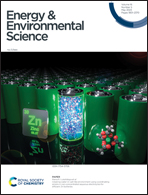Environmentally friendly anti-solvent engineering for high-efficiency tin-based perovskite solar cells†
Abstract
Tin-based perovskites are the most likely alternative candidates for lead-based counterparts due to their low toxicity and excellent optoelectronic properties. However, their uncontrollable crystallization process limits the improvement of device performance. Here, a green anti-solvent (acetic acid, HAc) has been first applied to adjust the crystallization process of tin-based perovskites, that is, to accelerate solution nucleation by salting-out crystallization and to slow down the crystal growth rate by hydrogen bond interactions. Furthermore, the non-volatilized residual HAc reduces the loss of organic amine salts and passivates defect states in the perovskites. Consequently, a device prepared using HAc realizes the highest efficiency of 12.78% (an open circuit voltage of 0.92 V) among non-chlorobenzene-based devices. Pioneeringly, we point out a general principle that the congeners of HAc, whose ability to form a hydrogen bond is not higher than that of HAc, can act as anti-solvents to prepare tin-based perovskites.



 Please wait while we load your content...
Please wait while we load your content...